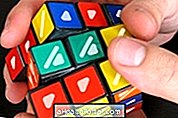Although the use of a specific color-blind glasses can make the person see all the colors, there is a color system called ADD, idealized by Miguel Neivas, which can be used in all types of color blindness.
The system consists of assigning a symbol for each primary color: red, yellow and blue and then the color combination can also be 'seen' by the colorblind because the symbols can be integrated. Thus, for the colorblind to learn to differentiate colors he must learn that red corresponds to a drawing, while yellow has another drawing and so does blue.
This technique can also be used for people with achromatopsia, for example. See the symptoms of this disease similar to color blindness.
Steps for the Colorblind Learn the Colors
The first step for the colorblind to be able to identify the colors is to learn the symbols that correspond to the primary colors that are yellow, red and blue:

After learning these colors through these symbols, the colorblind should learn to differentiate black and white in order to differentiate the light and dark tones:

The following may be able to differentiate the different colors:

Until then, it is able to differentiate beyond the colors, their tonalities: light and dark:

This color system can be used to bring social inclusion and increase the self-esteem and independence of the colorblind when it is included in games, crayons, clothing labels, parking lots and traffic signs, as shown in the following pictures:



Color blindness is a genetic disorder that especially affects men and has no cure or treatment whatsoever and the only way for people with color blindness to know how to identify color is through this method.

Usually the suspicion of color blindness arises in childhood when the child is learning colors, between 2 and 3 years of age. However, at this stage it is still not possible to close the diagnosis because in the child's imagination the sky may be pink and therefore the tests may be false. Therefore, the diagnosis is usually made later, when the child collaborates better with the tests.
Learn more about color blindness in:
- Understand what it is and what types of color blindness
How to test for color blindness
























